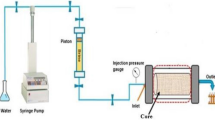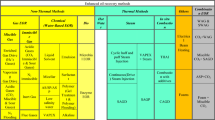Abstract
In this study, inverse emulsion polymerization (IEP) of acrylamide (AAm) and 2-acrylamido-2-methyl-1-propane sulfonic acid (AMPS) was conducted with a constant monomer AAm/AMPS feed ratio of 80%:20%. The effects of important reaction parameters on monomer conversion, intrinsic viscosity and molecular weight of nanostructured polymers (NSPs) were comprehensively assessed and the optimal synthesis conditions (in terms of the high molecular weight characteristics) was obtained using Box–Behnken design (BBD) combined with response surface methodology (RSM). The glass transition temperature (Tg) of the synthesized NSP was obtained at 165 °C by differential scanning calorimetry (DSC). The rheology measurements demonstrated the long–term stability of the synthetized NSPs after 50 days of aging at 90 °C within the 87,000 ppm brine. Regarding the high molecular weight and acceptable long–term stability at elevated temperatures and salinity levels, the synthesized NSP could be considered as potential candidates for enhanced oil recovery (EOR) applications under harsh condition reservoirs.








Similar content being viewed by others
References
Still T, Chen K, Alsayed AM, Aptowicz KB, Yodh AG (2013) Synthesis of micrometer-size poly (N-isopropylacrylamide) microgel particles with homogeneous crosslinker density and diameter control. J Colloid Interface Sci 405:96–102
Finch CA (2013) Chemistry and technology of water-soluble polymers. Springer Science & Business Media, New York
Seright RS, Lane RH, Sydansk RD (2003) A strategy for attacking excess water production. SPE Prod Facil 18(03):158–169
Al-Muntasheri GA, Nasr-EL-Din HA, Hussein IA (2007) A rheological investigation of a high temperature organic gel used for water shut-off treatments. J Petrol Sci Eng 59(1–2):73–78
Morgan SE, McCormick CL (1990) Water-soluble polymers in enhanced oil recovery. Prog Polym Sci 15(1):103–145
Yu X, Pu W, Chen D, Zhang J, Zhou F, Zhang R, Gu S (2015) Degradable cross-linked polymeric microsphere for enhanced oil recovery applications. RSC Adv 5(77):62752–62762
Irvine R, Davidson J, Baker M, Devlin R, Park H (2015). Nano spherical polymer pilot in a mature 18 API sandstone reservoir water flood in Alberta, Canada. In SPE Asia Pacific Enhanced Oil Recovery Conference, Kuala Lumpur, Malaysia
Durmaz S, Okay O (2000) Acrylamide/2-acrylamido-2-methylpropane sulfonic acid sodium salt-based hydrogels: synthesis and characterization. Polymer 41(10):3693–3704
Rosso F, Barbarisi A, Barbarisi M, Petillo O, Margarucci S, Calarco A, Peluso G (2003) New polyelectrolyte hydrogels for biomedical applications. Mat Sci Eng C Mater 23(3):371–376
Travas-Sejdic J, Easteal A (1998) Swelling equilibria and volume phase transition of polyelectrolyte gel with strongly dissociated groups. Polym Gels Netw 5(6):481–502
Kim SJ, Lee CK, Kim SI (2004) Electrical/pH responsive properties of poly (2-acrylamido-2-methylpropane sulfonic acid)/hyaluronic acid hydrogels. J Appl Polym Sci 92(3):1731–1736
Peng B, Peng S, Long B, Miao Y, Guo W (2010) Properties of high-temperature-resistant drilling fluids incorporating acrylamide/(acrylic acid)/(2-acrylamido-2-methyl-1-propane sulfonic acid) terpolymer and aluminum citrate as filtration control agents. J Vinyl Addit Techn 16(1):84–89
Kamal MS, Sultan AS, Al-Mubaiyedh UA, Hussien IA, Pabon M (2014) Evaluation of rheological and thermal properties of a new fluorocarbon surfactant-polymer system for EOR applications in high-temperature and high-salinity oil reservoirs. J Surfactant Deterg 17(5):985–993
Seright RS, Campbell AR, Mozley PS, Han P (2010) Stability of partially hydrolyzed polyacrylamides at elevated temperatures in the absence of divalent cations. SPE J 15(02):341–348
Hunkeler D (1992) Synthesis and characterization of high molecular weight water-soluble polymers. Polym Int 27(1):23–33
Pross A, Platkowski K, Reichert KH (1998) The inverse emulsion polymerization of acrylamide with pentaerythritolmyristate as emulsifier. 1. Experimental studies. Polym Int 45(1):22–26
Capek I (2004) Inverse emulsion polymerization of acrylamide initiated by oil-and water-soluble initiators: effect of emulsifier concentration. Polym J 36(10):793
Zhang D, Song X, Liang F, Li Z, Liu F (2006) Stability and phase behaviour of acrylamide-based emulsions before and after polymerization. J Phys Chem B 110(18):9079–9084
Blagodatskikh I, Tikhonov V, Ivanova E, Landfester K, Khokhlov A (2006) New approach to the synthesis of polyacrylamide in miniemulsified systems. Macromol Rapid Comm 27(22):1900–1905
Hamzah YB, Hashim S, Rahman WA (2017) Synthesis of polymeric nano/microgels: a review. J Polym Res 24(9):134
Barari M, Abdollahi M, Hemmati M (2011) Synthesis and characterization of high molecular weight polyacrylamide nanoparticles by inverse-emulsion polymerization. Iran Poly J 20(1):65–76
Singireddy A, Pedireddi SR, Subramanian S (2019) Optimization of reaction parameters for synthesis of cyclodextrin nanosponges in controlled nanoscopic size dimensions. J Polym Res 26(4):93
Agrawal D, Shrivastava Y, De SK, Singh PK (2019) Synthesis of post-metallocene catalyst and study of its olefin polymerization activity at room temperature in aqueous solution followed by prediction of yield. J Polym Res 26(7):167
Enayatzadeh M, Mohammadi T, Fallah N (2019) Influence of TiO2 nanoparticles loading on permeability and antifouling properties of nanocomposite polymeric membranes: experimental and statistical analysis. J Polym Res 26(10):240
Es-said A, El Moussaouiti M, Bchitou R (2019) Esterification optimization of cellulose with p-Iodobenzoyl chloride using experimental design method. J Polym Res 26(9):237
Jiang HL, Yang JL, Shi YP (2017) Optimization of ultrasonic cell grinder extraction of anthocyanins from blueberry using response surface methodology. Ultrason Sonochem 34:325–331
Raza A, Li F, Xu X, Tang J (2017) Optimization of ultrasonic-assisted extraction of antioxidant polysaccharides from the stem of Trapa quadrispinosa using response surface methodology. Int J Biol Macromol 94:335–344
Atkinson AC, Donev AN, Tobias RD (2007) Optimum experiment designs with SAS. Oxford University Press, Oxford
Zaroual Z, Chaair H, Essadki AH, El Ass K, Azzi M (2009) Optimizing the removal of trivalent chromium by electrocoagulation using experimental design. Chem Eng J 148:488–495
Sohrabi MR, Moghri M, Fard Masoumi HR, Amiri S, Moosavi N (2016) Optimization of reactive blue 21 removal by nanoscale zero-valent iron using response surface methodology. Arab J Chem 9(4):518–525
Unal O (2016) Optimization of shot peening parameters by response surface methodology. Surf Coat Technol 305:99–109
Box GEP, Wilson KB (1951) On the experimental attainment of optimum conditions. J R Stat Soc Series B Stat Methodol 13(1):1–38
Ferreira SLC, Bruns RE, Ferreira HS, Matos GD, David JM, Brandao GC, da Silva EGP, Portugal LA, dos Reis PS, Souza AS, Dos Santos WNL (2007) Box–Behnken design: an alternative for the optimization of analytical methods. Anal Chim Acta 597:179–186
Box GEP, Behnken DW (1960) Some new three level designs for the study of quantitative variables. Technometrics 2(4):455–475
Felix CS, Barreto JA, Novaes CG, Amorim FA, Lemos VA, Andrade H, da Silva EG (2019) Application of a novel ion-imprinted polymer to the separation of traces of CdII ions in naturalw: optimization by Box-Behnken design. J Braz Chem Soc 30(4):873–881
Jahangir MA, Khan R, Sarim Imam S (2018) Formulation of sitagliptin-loaded oral polymeric nano scaffold: process parameters evaluation and enhanced anti-diabetic performance. Artif cells. Nanomed Biotechnol 46(sup1):66–78
Imam SS, Aqil M, Akhtar M, Sultana Y, Ali A (2015) Formulation by design-based proniosome for accentuated transdermal delivery of risperidone: in vitro characterization and in vivo pharmacokinetic study. Drug Deliv 22(8):1059–1070
Mahdavi HR, Azizi N, Mohammadi T (2017) Performance evaluation of a synthesized and characterized Pebax1657/PEG1000/γ-Al2O3 membrane for CO2/CH4 separation using response surface methodology. J Polym Res 24(5):67
Flory PJ (1953) Principles of polymer chemistry. Cornell University Press, New York
Manaresi P, Munari A, Pilati F, Marianucci E (1988) A general intrinsic viscosity-molecular weights relationship for polydisperse polymers. Eur Polym J 24(6):575–578
Wu YM, Wang YP, Yu YQ, Xu J, Chen QF (2006) Dispersion polymerization of acrylamide with 2-acrylamido-2-methyl-1-propane sulfonate in aqueous solution. J Appl Polym Sci 102(3):2379–2385
Niu Y, Ouyang J, Zhu Z, Wang G, Sun G, Shi L (2001) Research on hydrophobically associating water-soluble polymer used for EOR. In SPE international symposium on oilfield chemistry, Houston, Texas
Melo MA, Holleben CR, Silva IG, Correia AB, Silva GA, Rosa AJ, Lins AG, Lima JC (2005) Evaluation of polymer-injection projects in Brazil. In SPE Latin American and Caribbean petroleum engineering conference, Rio de Janeiro, Brazil
Author information
Authors and Affiliations
Corresponding author
Additional information
Publisher’s note
Springer Nature remains neutral with regard to jurisdictional claims in published maps and institutional affiliations.
Rights and permissions
About this article
Cite this article
Seid Mohammadi, M., Sahraei, E. & Bayati, B. Synthesis optimization and characterization of high molecular weight polymeric nanoparticles as EOR agent for harsh condition reservoirs. J Polym Res 27, 41 (2020). https://doi.org/10.1007/s10965-020-2017-9
Received:
Accepted:
Published:
DOI: https://doi.org/10.1007/s10965-020-2017-9




